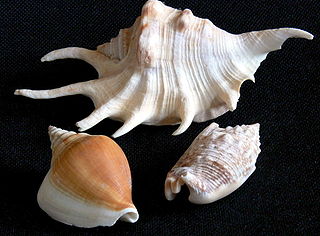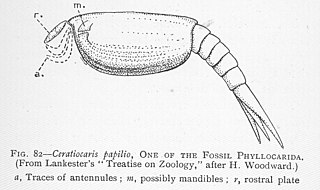Genus is a taxonomic rank used in the biological classification of living and fossil organisms as well as viruses, in biology. In the hierarchy of biological classification, genus comes above species and below family. In binomial nomenclature, the genus name forms the first part of the binomial species name for each species within the genus.

Strombidae, commonly known as the true conchs, is a taxonomic family of medium-sized to very large sea snails in the superfamily Stromboidea. The term true conchs, being a common name, does not have an exact meaning. It may refer generally to any of the Strombidae but sometimes is used more specifically to include only Strombus and Lambis. The family currently includes 23 extant, and 10 extinct genera.

Tube-dwelling anemones or ceriantharians look very similar to sea anemones but belong to an entirely different subclass of anthozoans. They are solitary, living buried in soft sediments. Tube anemones live inside and can withdraw into tubes, which are composed of a fibrous material made from secreted mucus and threads of nematocyst-like organelles known as ptychocysts. Within the tubes of these ceriantharians, more than one polyp is present, which is an exceptional trait because species that create tube systems usually contain only one polyp per tube. Ceriantharians were formerly classified in the taxon Ceriantipatharia along with the black corals but have since been moved to their own subclass, Ceriantharia.

Fagonia is a genus of wild, flowering plants in the caltrop family, Zygophyllaceae, having about 35 species. Species occurring in the US are commonly referred to as fagonbushes. The distribution of the genus includes parts of Africa, the Mediterranean Basin, the Mid-East, India, and parts of the Americas. Fagonia species have been used ethnobotanically by traditional practitioners under Ayurvedic and other healing regimes for many maladies. Species occur in deserts, dry washes, ditches and on rocky outcrops, including at altitude.
Palfuria is a spider genus of the family Zodariidae of which nine species from Africa have been described to date.
Palfuria harpago is a spider species of the family Zodariidae.

Phalloceros is a genus of poeciliids native to freshwater habitats in Brazil, Paraguay, Uruguay and northern Argentina. The majority are endemic to southern and southeastern Brazil. P. caudimaculatus has long been part of the aquarium industry and has been introduced to countries far from its native range.

Lambis is a genus of large sea snails sometimes known as spider conchs, marine gastropod mollusks in the family Strombidae, the true conch family.

Odostomia is the most speciose genus of minute sea snails, pyramidellid gastropod mollusks. This genus is placed in the family Pyramidellidae in the subfamily Odostomiinae. There are several hundred species in this diverse genus

Harpago chiragra, common name the Chiragra spider conch, is a species of very large sea snail, a marine gastropod mollusk in the family Strombidae, the true conchs.
Rhytidocystis is a genus of apicomplexans. It is the only genus within the monotypic family Rhytidocystidae. The species of this genus are parasitic protozoa found in marine annelids.

Laevistrombus canarium is a species of edible sea snail, a marine gastropod mollusc in the family Strombidae. Known from illustrations in books dating from the late 17th century, L. canarium is an Indo-Pacific species occurring from India and Sri Lanka to Melanesia, Australia and southern Japan. The shell of adult individuals is coloured from light yellowish-brown to golden to grey. It has a characteristic inflated body whorl, a flared, thick outer lip, and a shallow stromboid notch. The shell is valued as an ornament, and because it is heavy and compact, it is also often used as a sinker for fishing nets.

Freshwater snails are gastropod mollusks which live in fresh water. There are many different families. They are found throughout the world in various habitats, ranging from ephemeral pools to the largest lakes, and from small seeps and springs to major rivers. The great majority of freshwater gastropods have a shell, with very few exceptions. Some groups of snails that live in freshwater respire using gills, whereas other groups need to reach the surface to breathe air. In addition, some are amphibious and have both gills and a lung. Most feed on algae, but many are detritivores and some are filter feeders.

Harpago arthriticus, common name : the arthritic spider conch, is a species of sea snail, a marine gastropod mollusk in the family Strombidae, the true conchs.

Ceratiocaris is a genus of paleozoic phyllocarid crustaceans whose fossils are found in marine strata from the Upper Ordovician until the genus' extinction during the Silurian. They are typified by eight short thoracic segments, seven longer abdominal somites and an elongated pretelson somite. Their carapace is slightly oval shaped; they have many ridges parallel to the ventral margin and possess a horn at the anterior end. They are well known from the Silurian Eramosa formation of Ontario, Canada.
Mesodinium chamaeleon is a ciliate of the genus Mesodinium. It is known for being able to consume and maintain algae endosymbiotically for days before digesting the algae. It has the ability to eat red and green algae, and afterwards using the chlorophyll granules from the algae to generate energy, turning itself from being a heterotroph into an autotroph. The species was discovered in January 2012 outside the coast of Nivå, Denmark by professor Øjvind Moestrup.
Bennelongia is a genus of ostracod crustaceans in the family Cyprididae. It is probably endemic to Australia and New Zealand, and is predicted to be highly diverse. The genus was described in 1981 and named after Woollarawarre Bennelong, the first aboriginal to have a long association with the early European settlers of Australia. Prior to 2012, six species were described in Australia. There are currently 15 species of Bennelongia. Bennelongia may be the last true descendent genus of the Mesozoic lineage of Cypridea, which was a dominant lineage of ostracod in non-marine waters in the Cretaceous.
Veloxidium is a genus of parasitic alveolates in the phylum Apicomplexa. Species in this genus infect marine invertebrates.
The Platyproteum are a genus of parasitic alveolates in the phylum Apicomplexa. Species in this genus infect marine invertebrates.
John Ernest "Jack" Randall was an American ichthyologist and a leading authority on coral reef fishes. Randall described over 800 species and authored 11 books and over 900 scientific papers and popular articles. He spent most of his career working in Hawaii. He died in April 2020 at the age of 95.













